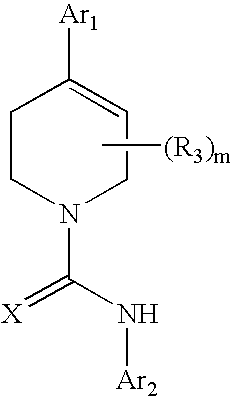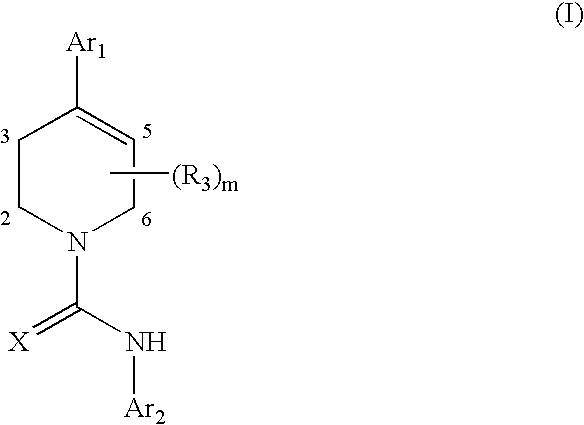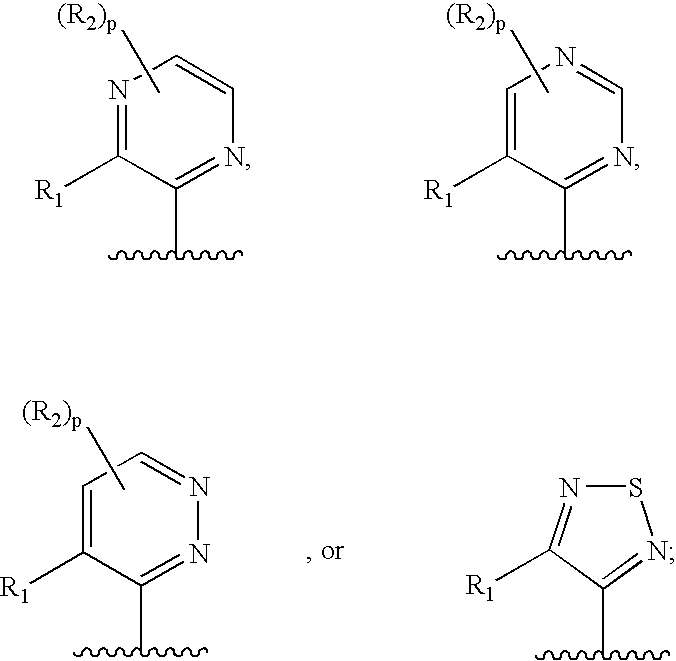Therapeutic agents useful for treating pain
a technology of tetrahydropiperidyl and therapeutic agents, which is applied in the field of tetrahydropiperidyl compounds, can solve the problems of ineffective drugs, no existing commercial drug treatment for ui patients has achieved complete success in all classes of ui patients, and treatment has not been significant adverse side effects
- Summary
- Abstract
- Description
- Claims
- Application Information
AI Technical Summary
Benefits of technology
Problems solved by technology
Method used
Image
Examples
example 1
5.1 Example 1
Synthesis of a Tetrahydropiperidyl Compound J37(c)
[0445]
[0446] A solution of 4-tert-butyl phenyl isocyanate 22 (2.45 g, 14 mmol) (commercially available from Sigma-Aldrich, St. Louis, Mo. (www.sigma-aldrich.com)) in DCM (7 mL) was added to a solution of 1,4-dioxa-8-azaspiro[4,5]decane 21 (2 g, 14 mmol) (commercially available from Sigma-Aldrich, St. Louis, Mo. (www.sigma-aldrich.com)) in DCM (7 mL) at about 25° C. and the resulting reaction mixture was allowed to stir for 5 minutes. The solvent was removed under reduced pressure to provide a compound of formula 23. The compound of formula 23 was dissolved in THF (20 mL) and 1N HCl in acetic acid (30 mL) was added to the solution. The resulting reaction mixture was then heated at reflux temperature for about 3 h, cooled to about 25° C., and the solvent removed under reduced pressure to provide a residue. The resulting residue was dissolved in DCM, neutralized with saturated aqueous Na2CO3 solution, and the organic layer...
example 2
5.2 Example 2
Synthesis of a Tetrahydropiperidyl Compound J39(c)
[0451]
[0452] A solution of 4-iso-propyl phenyl isocyanate 27 (2.25 g, 14 mmol) (commercially available from Sigma-Aldrich, St. Louis, Mo. (www.sigma-aldrich.com)) in DCM (7 mL) was added to a solution of 1,4-dioxa-8-azaspiro[4,5]decane 21 (2 g, 14 mmol) (commercially available from Sigma-Aldrich, St. Louis, Mo. (www.sigma-aldrich.com)) in DCM (7 mL) at about 25° C. and the resulting reaction mixture was allowed to stir for 5 minuets. The solvent was removed under reduced pressure to provide a compound of formula 28. The compound of formula 28 was dissolved in DCM (30 mL) and trifluoroacetic acid (15 mL) was added to the solution. The resulting reaction mixture was then heated at reflux temperature for about 5 hours, cooled to about 25° C., and the solvent removed under reduced pressure to provide a residue. The resulting residue was dissolved in DCM, neutralized with saturated aqueous Na2CO3 solution, and the organic la...
example 3
5.3 Example 3
Synthesis of a Tetrahydropiperidyl Compound J44(c)
[0457]
[0458] A solution of 4-trifluoromethylphenyl isocyanate 31 (6.86 g) (commercially available from Sigma-Aldrich, St. Louis, Mo. (www.sigma-aldrich.com)) was added in one portion to a solution of 1,4-dioxa-8-azaspiro[4,5]decane 21 (5 g) (commercially available from Sigma-Aldrich, St. Louis, Mo. (www.sigma-aldrich.com)) in DCM (40 mL) at about 25° C. and the resulting reaction mixture was allowed to stir for about 2 h. The solvent was removed under reduced pressure to provide a compound of formula 32.
[0459] The compound of formula 32 was dissolved in THF (100 mL) and 2N HCl (100 mL) was added to the solution. The resulting reaction mixture was then heated at about 50° C. for about 4 h and cooled to about 25° C. The aqueous and organic layers were then separated, the aqueous layer was extracted with ethyl acetate (100 mL), and the organic layers were combined. The combined organic layers were then dried (MgSO4) and t...
PUM
 Login to View More
Login to View More Abstract
Description
Claims
Application Information
 Login to View More
Login to View More - R&D
- Intellectual Property
- Life Sciences
- Materials
- Tech Scout
- Unparalleled Data Quality
- Higher Quality Content
- 60% Fewer Hallucinations
Browse by: Latest US Patents, China's latest patents, Technical Efficacy Thesaurus, Application Domain, Technology Topic, Popular Technical Reports.
© 2025 PatSnap. All rights reserved.Legal|Privacy policy|Modern Slavery Act Transparency Statement|Sitemap|About US| Contact US: help@patsnap.com



